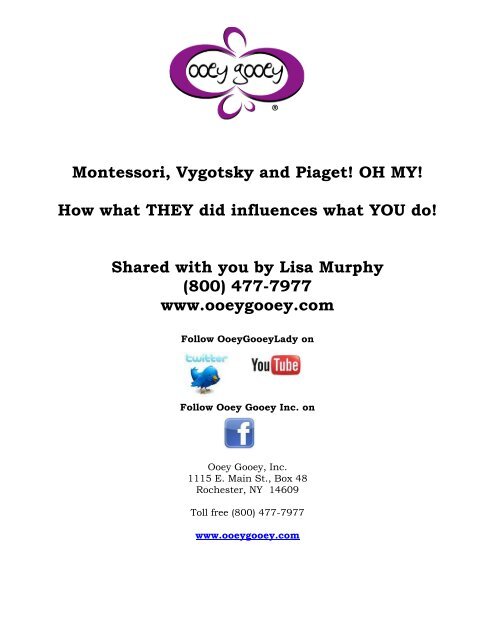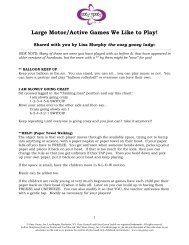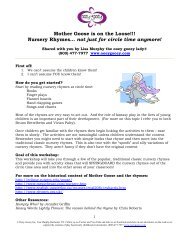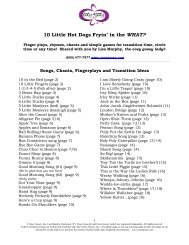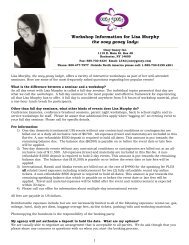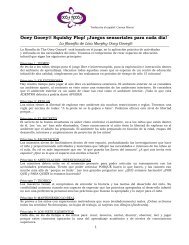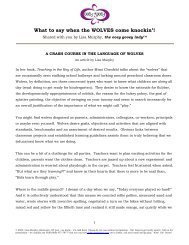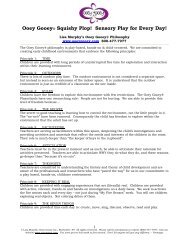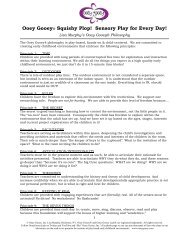meet the masters_rev.. - Ooey Gooey, Inc.
meet the masters_rev.. - Ooey Gooey, Inc.
meet the masters_rev.. - Ooey Gooey, Inc.
You also want an ePaper? Increase the reach of your titles
YUMPU automatically turns print PDFs into web optimized ePapers that Google loves.
Montessori, Vygotsky and Piaget! OH MY!How what THEY did influences what YOU do!Shared with you by Lisa Murphy(800) 477-7977www.ooeygooey.comFollow <strong>Ooey</strong><strong>Gooey</strong>Lady onFollow <strong>Ooey</strong> <strong>Gooey</strong> <strong>Inc</strong>. on<strong>Ooey</strong> <strong>Gooey</strong>, <strong>Inc</strong>.1115 E. Main St., Box 48Rochester, NY 14609Toll free (800) 477-7977www.ooeygooey.com
Meet A MasterFriedrich Froebel 1782-1852 (70)• Lived in Germany• His mo<strong>the</strong>r died when he was only 1• Grew up playing in gardens, fell in love with nature andnatural environs• Became a teacher in FrankfurtBelieved:• Hands-on learning was best• Children need to be active• Active and direct observation is <strong>the</strong> best way to planeducation• Children needed to be engaged in self directed activities and<strong>the</strong> teacher was to serve as <strong>the</strong> guideFroebel is credited with inventing Kinder-garden at some pointbetween 1837 and 1840. Frank Lloyd Wright attended aFroebelian Kinder-garden and you saw evidence of it in hisdrawings and designs. Read more at:http://www.geocities.com/a<strong>the</strong>ns/Forum/7905/web2000.htmlGoals for his Kindergarteners:1. Physical activity2. Physical dexterity3. Sensory awareness4. Creative expression5. Exploration of ideas and concepts By: Norman Brosterman6. Singing7. Experience of being with o<strong>the</strong>rs8. Satisfaction of <strong>the</strong> soulhttp://www.froebelfoundation.org/philosophy.htmlFor more about <strong>the</strong> philosophy and <strong>the</strong> gifts.By: Scott Bultman2Shared with you by Lisa Murphy www.ooeygooey.com (800) 477-7977
3Shared with you by Lisa Murphy www.ooeygooey.com (800) 477-7977
Meet A MasterMaria Montessori 1870 – 1952 (82)• Montessori began her career as a medical student with a specialtyin pediatrics• She was <strong>the</strong> first woman to graduate from an Italian medicalschool• She worked with children in asylums and realized that <strong>the</strong>children did not have problems – <strong>the</strong>ir environments did!• Came to be called “teacher” by her peers• Opened Casa Di Bambini to keep <strong>the</strong> children off <strong>the</strong> streets in <strong>the</strong>slums of Rome (at <strong>the</strong> request of <strong>the</strong> government)• No materials for children so she made <strong>the</strong>m• Within 6 years of opening Casa Di Bambini in Rome <strong>the</strong>re wereover 100 schools in <strong>the</strong> USA following a “Montessori” philosophy• Maria left Italy for political reasons in <strong>the</strong> 1930s and she lived ou<strong>the</strong>r days in India, England and HollandKey Points:• The notion of “child-sized” was nonexistent before MariaMontessori invented it• Having <strong>the</strong> stuff does not make you “Montessori”• Her ideas have influenced every preschool – Montessori or not• Control and establish <strong>the</strong> environment• The environment should be prepared, beautiful, orderly and shallhave lots of opportunity to engage <strong>the</strong> senses• Children need real tools and accessible equipment• Children need free time to explore• Teachers need to prepare <strong>the</strong> space and <strong>the</strong>n step back andfacilitate• Don’t pull <strong>the</strong> children away when <strong>the</strong>y are engaged• OBERVE OBSERVE OBSERVE• The teacher should always be learning right with <strong>the</strong> children. Is<strong>the</strong> space working? Not working? What can I do about it?Book Suggestions (all by Maria Montessori unless o<strong>the</strong>rwise noted)The Absorbent Mind The Secret of ChildhoodThe Essential Montessori (By Elizabeth Hainstock)Dr. Montessori’s Own HandbookBasic Montessori (By David Gettman)The children are now working as if I do not exist.-Maria Montessori4Shared with you by Lisa Murphy www.ooeygooey.com (800) 477-7977
Meet A MasterLev Vygotsky 1896-1934 (38)• Studied literature at University of Moscow• Usually associated with cognitive and language development• Through observations noticed that within a group of childrenat <strong>the</strong> same “level” <strong>the</strong>re were some that learned with littlehelp and some who needed more assistance• Often hear his name when folks are talking aboutConstructivismPrimary Contributions and Beliefs• The interaction between children and teachers and its vitalrole in advancing knowledge• ZPD = <strong>the</strong> zone of proximal development. The differencebetween what a child can do on his/her own and what <strong>the</strong>ycan do with assistance (from ei<strong>the</strong>r a peer or an adult)• When this “assistance” is offered it is referred to as“scaffolding”• Keen observation is at <strong>the</strong> core of effective and successfulscaffolding. Scaffolding is NOT “pushing”• Suggested to use props, real materials and loose parts in <strong>the</strong>environment• Valued conversations and working toge<strong>the</strong>r• Viewed observations are just as important as test scores• Believed learning takes place when children playOf note: Vygotsky is often lost in <strong>the</strong> shadow of Jean Piaget. Vygotsky died after along battle with TB. It is often thought that had he lived longer his contributionswould have rivaled those of Piaget.5Shared with you by Lisa Murphy www.ooeygooey.com (800) 477-7977
6Shared with you by Lisa Murphy www.ooeygooey.com (800) 477-7977
Meet A MasterRudolf Steiner (Waldorf) 1861-1925 (64)Steiner was an Austrian philosopher and spiritual scientist whobelieved that we must awaken to our own inner nature and <strong>the</strong>spiritual realities of outer nature and <strong>the</strong> cosmos. He believedthat <strong>the</strong> awareness of this relationship brings greater <strong>rev</strong>erence forlife.Clarification: although this is <strong>the</strong> <strong>the</strong>oretical basis of his“method” it is not taught to <strong>the</strong> students.So if his name is Steiner, why is <strong>the</strong> <strong>the</strong>ory, style and philosophyreferred to as “Waldorf”? Well now that’s an interesting story!Key points of a Waldorf education:• Learning through doing• De-emphasis on “academics” in <strong>the</strong> early grades• Strong focus on social skills• Children often learn to read from <strong>the</strong>ir own writing• Ideally <strong>the</strong> same group stays toge<strong>the</strong>r for <strong>the</strong> first 8 years• Traditional “frills” are central to a Waldorf style: music, art,gardening, crafts, etc.• Children are taught to knit, play <strong>the</strong> recorder and a stringedinstrument• Waldorf strongly discourages electronic mediaWaldorf schools often say <strong>the</strong>y provide an education of<strong>the</strong> HEART <strong>the</strong> HAND and <strong>the</strong> MIND7Shared with you by Lisa Murphy www.ooeygooey.com (800) 477-7977
Meet A MasterReggio EmiliaClarification: The <strong>the</strong>ory often referred to simply as “Reggio” is not aperson, but a place. It is a city in Italy. It is <strong>the</strong> philosophy which hasbeen actively growing out of this town since <strong>the</strong> early 1990s.Caution! As Americans we are often easily seduced by trappings thatappear to be essential cornerstones of a “philosophy.” We must takecare. You don’t become Reggio by taking your clocks down, having anart room/workshop (atelier), buying a light table, using a photodocumentation board and by draping crepe-like fabric from <strong>the</strong> ceiling.It really is a way of thinking. It is a WAY OF LIFE. It is truly aninspiration for all educators. Yet in its purest form it couldn’t workhere. Why not? It is culturally, socially and community based. Andsimply stated, it’s not our culture. From <strong>the</strong>ir website:http://zerosei.comune.re.it/inter/reggiochildren.htmReggio Children is a mixed public-private company that <strong>the</strong> Municipality of Reggio Emilia, alongwith o<strong>the</strong>r interested subjects, decided to establish in 1994 to manage <strong>the</strong> pedagogical and culturalexchange initiatives that had already been taking place for many years between <strong>the</strong> municipal earlychildhood services and a large number of teachers and researchers from all over <strong>the</strong> world. This newexperience was based on an idea originally proposed by Loris Malaguzzi and carried on by acommittee of local citizens and educators. Reggio Children's aims and purposes are inspired by <strong>the</strong>philosophy and values of <strong>the</strong> educational project developed and practiced in <strong>the</strong> Municipal InfanttoddlerCenters and Preschools of Reggio Emilia, in order to protect and communicate <strong>the</strong> wealth ofknowledge developed within this experience.Overheard at a conference: “We can’t be Reggio anymore because it violated a fire code…”Principles:• Emergent Curriculum & Project Work• Strong Use of <strong>the</strong> arts• Collaboration• Teacher as researcher• Documentation• The environment as <strong>the</strong> “Third Teacher”• The interlinking of society, school and family• Time not set by <strong>the</strong> clock8Shared with you by Lisa Murphy www.ooeygooey.com (800) 477-7977
Meet a MasterJean Piaget 1896-1980 (84)• Piaget had a PhD in biology & psychology• Initially took a job standardizing a French version of a BritishIQ test and noticed consistent similarities in <strong>the</strong> wronganswers <strong>the</strong> children were giving at certain ages• He wondered “what thought process are <strong>the</strong>y using???”• Piaget is <strong>the</strong> USA’s primary preschool influenceKey Points of his <strong>the</strong>ories:• Free Play• Real experiences• Children allowed to do things for <strong>the</strong>mselves• Children learn when curiosity is satisfied• The teacher’s job is to nurture inquiry• Play is important for learning• Teachers need to provide problem solving challenges,not just give out information• Curiosity and wonder are key ingredients to learning –cannot “make” <strong>the</strong>m learn• Children build knowledge through what <strong>the</strong>y do andexperienceStages that influence our age group:Sensorimotor 0-18 months• Object permanence• Separation anxietyPreoperational thought 18 mos – 6 years• Literal – ness• Over generalizations9Shared with you by Lisa Murphy www.ooeygooey.com (800) 477-7977
Meet A MasterJohn Dewey 1859-1952 (93)• Started as a philosopher (Chicago based for <strong>the</strong> major part ofhis work)• He is <strong>the</strong> American educator who influenced our field <strong>the</strong>most• Became “friends” (ahem) with student Alice Chipman, whowas interested in social problems and how <strong>the</strong>y linked toeducation• Dewey was interested in her research, <strong>the</strong>y eventuallymarried• Dewey was leading <strong>the</strong> “Progressive” educational movementwhile Piaget was in Switzerland and Montessori in Italy. Theywere all influencing <strong>the</strong> same time frameKey Points:• Children learn by doing. This was a RADICAL idea when heproposed it• Children need real experiences• Experiences should encourage both experimentation andindependent thinking• Education and life are interrelated – <strong>the</strong>y cannot beseparated!Education should be:• Child centered does not = CHAOS!• Interactive• Most involve <strong>the</strong> child’s social world to make it relevant• Planned and based on interests and observations• More than just “fun”Teachers should be able to articulate <strong>the</strong>ir intention and purpose.10Shared with you by Lisa Murphy www.ooeygooey.com (800) 477-7977


